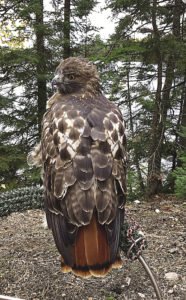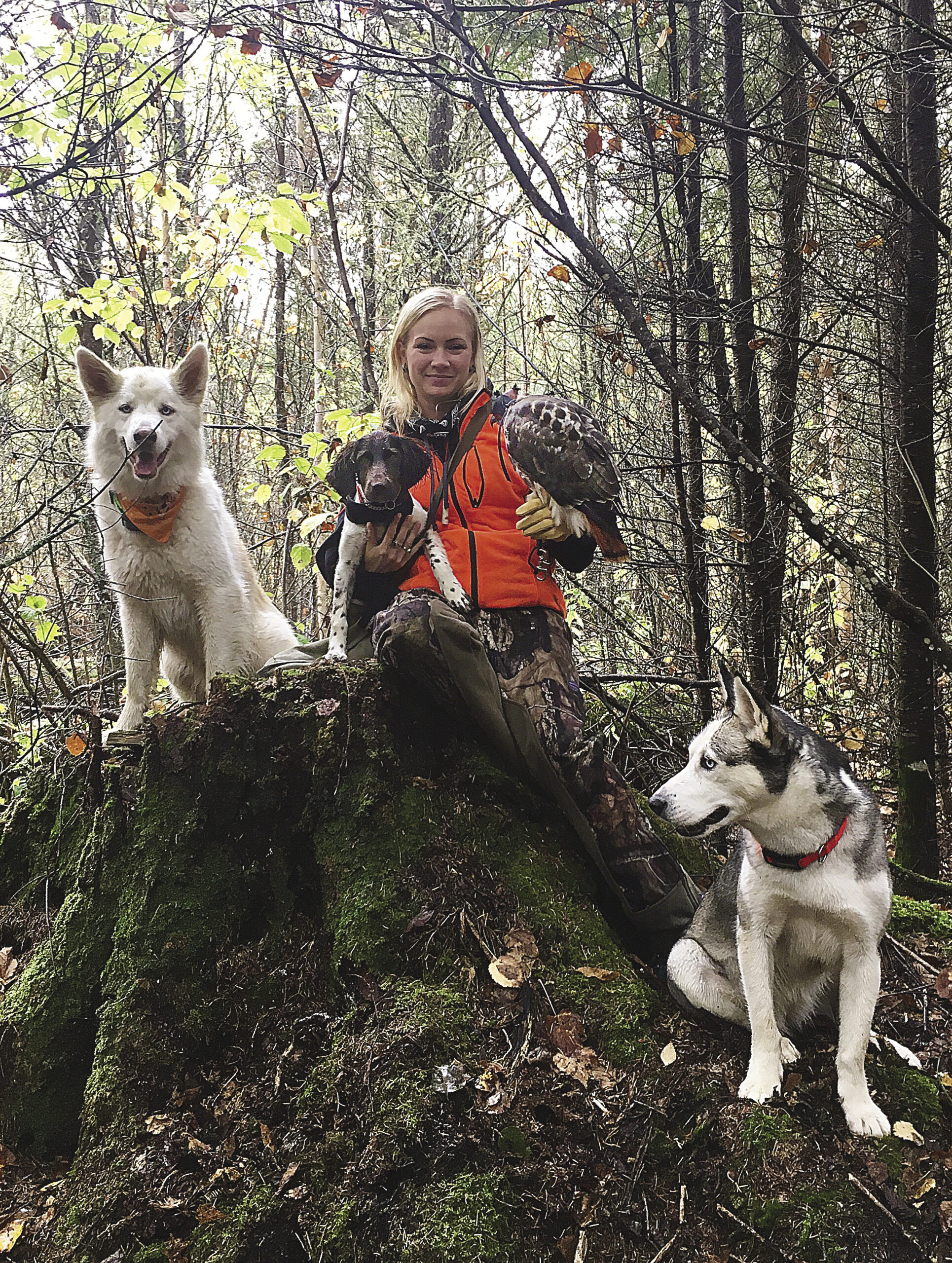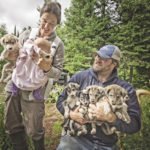Our flightless human bodies can’t achieve that status alone. But while I was out with my friend Jenn Salo, an apprentice falconer, I realized that forming relationships with birds of prey can also offer the vicarious thrill of flying.
That’s the sensation I felt when I watched her bird, a one-year-old red-tailed hawk, soar above us on a clear afternoon. On this day, we took him out of his pen in the city and down a cut road into an open clearing to fly.
A little over a year ago, Jenn trapped Sitka from the wild on the outskirts of Thunder Bay, signaling the start of her 15 month journey into falconry apprenticeship.
The red-tailed hawk is a medium-sized bird of prey and the most widely-distributed bird of its kind in North America. Valued by entry-level falconers for their forgiving attitudes and aptitude for human interaction, they have a lengthy history of working with people.
“There are so many wild red-tails out there that have come from lineages that have been tamed by humans and then let go again,” says Jenn.
Making use of predatory birds like falcons, hawks and eagles to obtain food is a traditional form of hunting dating from as far back as 1300 B.C. in regions including Ancient Egypt and the Asian Steppes, eventually migrating into Indo-Pakistan, the Islamic world, and the British Isles, according to the International Association for Falconry and Conservation of Birds of Prey.
The United Nations Organization for Education, Science and Culture (UNESCO) lists falconry as an official example of intangible cultural heritage. Over time, its practice has evolved to become associated with nature conservation, cultural heritage and social engagement within and amongst ethnic communities.
Since Sitka has come under her care, Jenn has been guarding him from the threat of predators and starvation while cautiously straddling the worlds of wild and domestic. The intent is for him to remain an efficient hunter, for both his benefit and hers.

“I’ve kept him safe through the most critical period of his life. Seventy percent of all raptors don’t make it the first year,” says Jenn. “This bird knows he’s never going to starve to death in my care, so that’s where the security of being with a human comes in.”
For a small game hunter like Jenn, hunting with Sitka is about as natural as it gets, and satisfies her need to reconcile a moral dilemma that she’s faced since childhood.
“I was always excited to go hunting with my dad, but felt really bad for the animal because it had no chance whatsoever.”
As a lover of wildlife, she’s also keen to avoid the use of lead, which can accumulate in larger predators as they consume the abandoned carcasses of smaller creatures.
“We’re not leaving anything behind when I hunt with a hawk. When you’re hunting with a gun, you’re leaving gut piles, you’re leaving lead shards. Even when you don’t think you’re leaving lead, yes, you are.”
For now, Jenn’s focus is training Sitka to become her hunting companion before her apprenticeship period ends in December.
“[By then] I have to prove that me and Sitka know what we’re doing… Because if I can’t hunt this bird, then the chances of me being able to let him go are pretty slim because he doesn’t know how to take care of himself anymore,” Jenn told me during our interview at the end of September.
This is the pair’s first real season hunting small game. Last year, Jenn focused on working Sitka down to his ideal weight and socialized him with other humans and critters.
“His ideal weight is around 800 grams to be hunting and focused on anything that moves,” she says, placing Sitka on a small kitchen scale in her back yard.
She compares it to boxing: “It’s a fighting fitness. That would be the hunting weight for a hawk—not too fat, and not too thin. You’ve got to find that fine line in between.”
He clocked in at 840 grams: a little on the heavier side, but good enough to fly.
On this September day, the air was crisp and the sun was out—a perfect fall afternoon for us two women, three dogs and a hawk to pile into my car and head down a cut road north of the highway toward Armstrong, Ontario.
Sitka wears a leather hood to calm him while he’s in transit. He also wears anklets made from the same material, so if he ever decided to fly free, they would degrade and eventually fall off. He sat on Jenn’s hand, which was sheathed in a protective leather gauntlet, taking curious stares, smiles of approval, and the odd thumbs up from drivers who stopped beside us at traffic lights.
We drove down a dirt road and came to a clearing dotted sparsely with poplar snags and spruce trees—perfect spots for Sitka to perch while he’s following our pack from a distance.
On that note, Jenn attached bells to her bird’s ankles as we approached our parking spot. After everyone piled out of my car, Jenn took off his hood, detached a leather cord from his ankles, and let Sitka free.
Within seconds, he was soaring with open wings and riding the thermal currents of the wind. As we watched him climb high into the air, I was, like Jenn, captivated by his sense of freedom.
We watched him fly from tree to tree every few hundred meters, staying behind us but following along. Like a hawk in turn, Jenn watched his every move. Eventually she pulled a small rodent from her bag, blew two high-pitched peeps with her whistle, and waved the lifeless creature in her hand to call him back to her arm.
No response—Sitka stayed perched a few hundred meters away from us high on the tip of a spindly spruce tree. Clearly, he was enjoying his freedom and in no hurry to return.
“Every time I let him fly, my stomach is in my throat,” Jenn tells me. “It’s his choice for him to stay here or not. He could just tip his wing in the other direction and say, ‘see ya.’”
But this time, he doesn’t. Jenn is prepared. Unbeknownst to me she has another surprise in her bag. She pulls out a tiny quail and ties it to a string. Sitka sees it too, with his ability to spot small prey from 100 feet in the air.
As I hold back the dogs, Jenn places the bird in an open area and stands back. Sitka immediately swoops down from the spruce top, targeting the bait. Once he’s poised above the quail he dives straight down in split-second timing for the kill. In these predatory moments, red-tailed hawks can reach impressive speeds of 120 miles per hour.
Jenn approaches Sitka, who seems quite comfortable enjoying his meal in the presence of bystanders. Eventually I join with the three curious dogs, and Sitka pays no mind as we all sit together in a semi-circle on a crisp bed of fallen poplar leaves.
“He’s pretty much one of the dogs, but with wings,” says Jenn, who’s more relaxed in her demeanor now that Sitka has returned.
“I’m starting to enjoy when he starts soaring. Obviously he loves to soar, and I love seeing him soar—that’s what he’s made to do. Just getting that base of trust and knowing that okay, he kind of likes me, he knows I’ve got food in my pocket. He’s keeping me in sight.”
When it comes to falconry, Jenn finds the relationship with a wild animal the most fascinating. But her intentions only go so far. In good time, and when he’s ready, Jenn will let her beloved, copper-feathered raptor, go for good.
“And then I get to start all over again,” she tells me, as if she’s rubbing her hands together with scheming, child-like excitement. “I one hundred percent can’t wait to try a new bird—I love Sitka to pieces, but I can’t wait until he gets to go free.”




